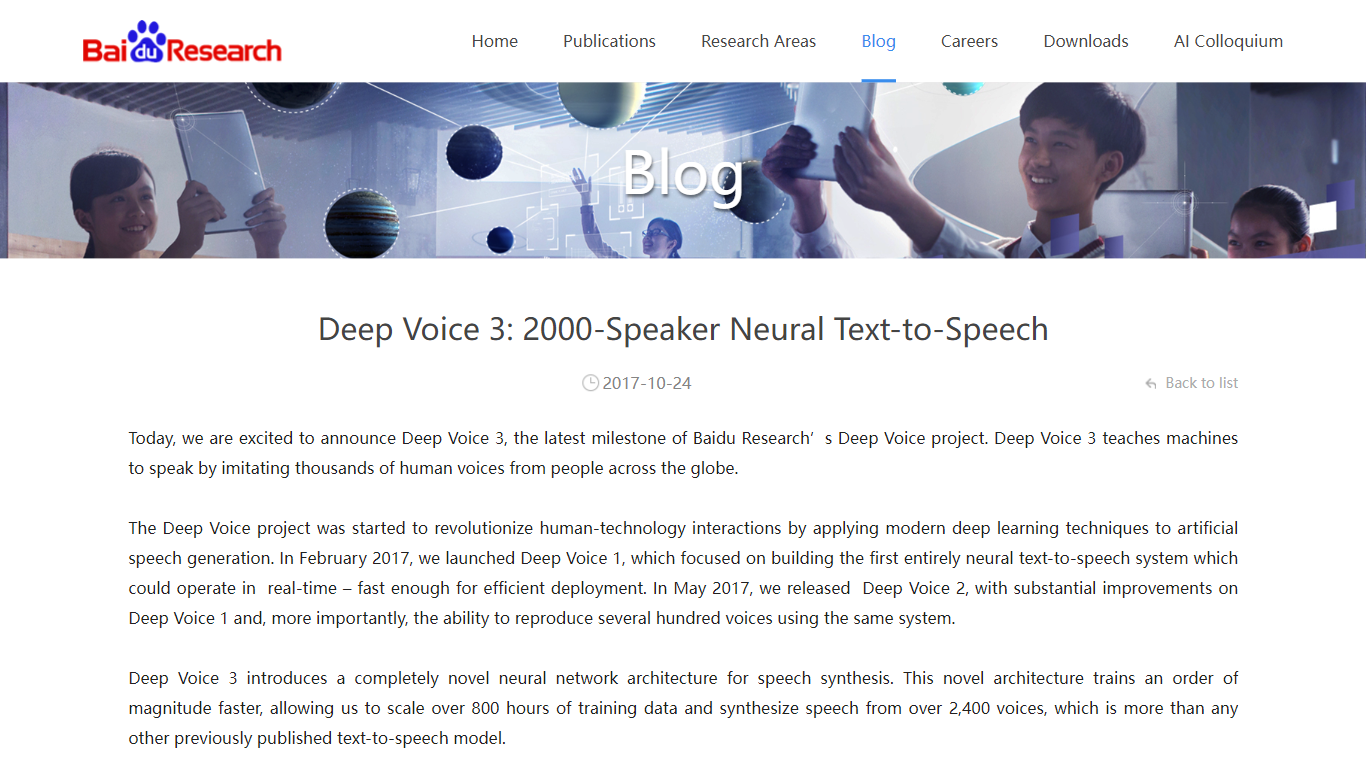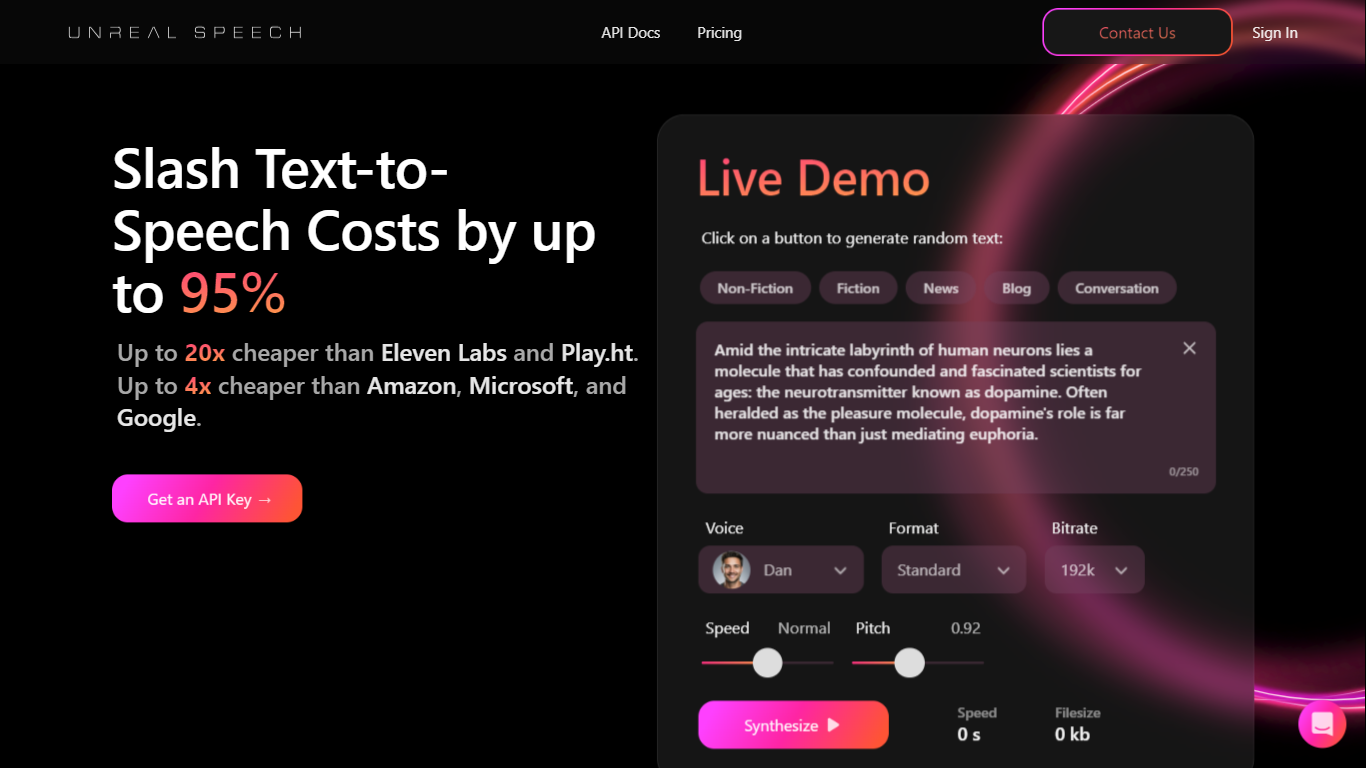Deep Voice 3 vs Unreal Speech
When comparing Deep Voice 3 vs Unreal Speech, which AI Text to Speech (TTS) tool shines brighter? We look at pricing, alternatives, upvotes, features, reviews, and more.
Between Deep Voice 3 and Unreal Speech, which one is superior?
When we put Deep Voice 3 and Unreal Speech side by side, both being AI-powered text to speech (tts) tools, Unreal Speech is the clear winner in terms of upvotes. Unreal Speech has been upvoted 9 times by aitools.fyi users, and Deep Voice 3 has been upvoted 6 times.
Want to flip the script? Upvote your favorite tool and change the game!
Deep Voice 3

What is Deep Voice 3?
Deep Voice 3 is an open source text-to-speech system that uses a fully convolutional neural network to convert text into natural-sounding speech. It supports both single-speaker and multi-speaker models, allowing it to generate speech in various voices and accents. The system is designed to scale efficiently, handling large datasets and training quickly compared to traditional TTS models.
The architecture includes an encoder that processes text inputs, an attention-based decoder that predicts mel-scale spectrograms, and a converter network that generates vocoder parameters for waveform synthesis. This design helps produce clear and natural speech with fewer mispronunciations. Deep Voice 3 also supports training on phoneme, character, or mixed inputs, which improves pronunciation accuracy.
Recent implementations have demonstrated the model's ability to synthesize speech from multiple speakers with distinct accents and ages, showcasing its versatility. Audio samples from various English accents, including Southern England and Scottish, highlight its adaptability to different speech styles.
Deep Voice 3 is suitable for developers and researchers interested in building scalable, high-quality TTS applications. Its open source nature allows customization and experimentation with different model configurations and datasets.
While the core technology remains consistent with the original design, ongoing community efforts focus on improving training efficiency and expanding multi-speaker capabilities. The system's modular structure facilitates integration with other speech processing tools and vocoders.
Overall, Deep Voice 3 offers a balance of speed, scalability, and speech quality, making it a valuable resource for those working on speech synthesis projects that require flexibility across voices and languages.
For detailed technical insights and implementation guidance, the original research paper and open source repositories provide comprehensive resources.
Unreal Speech

What is Unreal Speech?
Unreal Speech offers an affordable text-to-speech API that delivers high-quality voice synthesis at a fraction of the cost of major competitors. It uses the Kokoro TTS engine, an efficient open-source model with just 82 million parameters, enabling fast and natural speech generation. The API supports streaming audio in as little as 300 milliseconds and can produce long-form audio up to 10 hours in length, making it suitable for real-time applications and extensive content creation.
The platform targets developers, content creators, and businesses looking for a cost-effective, production-ready TTS solution. It supports 48 distinct voices across 8 languages including English, French, Hindi, Spanish, Japanese, Chinese, Italian, and Portuguese, with multiple accents and speaking styles. Users benefit from features like per-word timestamps, which allow synchronization of text and speech for enhanced accessibility and interactive applications.
Unreal Speech's value proposition centers on drastically reducing text-to-speech costs—up to 11 times cheaper than Eleven Labs and significantly more affordable than Amazon, Microsoft, and Google offerings. This makes it an attractive choice for startups, educators, and enterprises aiming to scale voice applications without high expenses.
Technically, the Kokoro TTS model combines elements of StyleTTS 2 and iSTFTNet in a streamlined decoder-only architecture. This design eliminates the need for separate vocoders or complex multi-stage pipelines, resulting in faster synthesis without sacrificing audio quality. The model generates 24kHz high-fidelity audio efficiently, suitable for both batch processing and real-time streaming.
Users can access the API with a free tier offering 250,000 characters monthly, and scale up with volume-based pricing plans. Additionally, Kokoro TTS can be self-hosted via Python packages or command-line tools, providing flexibility for offline or privacy-sensitive applications.
Overall, Unreal Speech stands out by combining open-source innovation with enterprise-grade API reliability, making advanced text-to-speech technology accessible and affordable for a wide range of use cases.
Deep Voice 3 Upvotes
Unreal Speech Upvotes
Deep Voice 3 Top Features
🎤 Multi-speaker support with varied accents and ages for diverse voices
⚡ Fast training speeds enabling quicker model development
🧩 Flexible input options using phonemes, characters, or both for better pronunciation
🔊 Generates mel-scale spectrograms for high-quality audio synthesis
🔧 Open source codebase allowing customization and integration
Unreal Speech Top Features
💸 Extremely low cost API reduces TTS expenses significantly
⚡ Streams audio in 300 milliseconds for real-time apps
🗣️ Supports 48 natural voices across 8 languages
⏱️ Provides per-word timestamps for text-audio syncing
🎧 Generates long-form audio up to 10 hours in length
Deep Voice 3 Category
- Text to Speech (TTS)
Unreal Speech Category
- Text to Speech (TTS)
Deep Voice 3 Pricing Type
- Freemium
Unreal Speech Pricing Type
- Freemium
